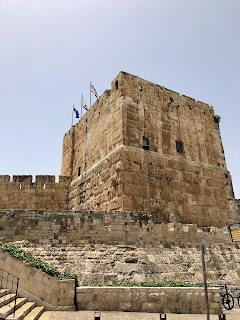-->
This morning we arrived at Al’ Aqaba, the only port of the
Hashemite Kingdom of Jordan. Yes,
that is the official name of this country. King Abdullah II, the current ruler, is a direct descendant
of the prophet Mohammed (something like a 43rd great-grandson).
Aqaba (for short) is at the head of the Gulf of Aqaba and in
quite an interesting location.
Only a few miles to its east is Saudi Arabia and to its west is Eliat,
Israel. In fact one can see the
lights and buildings of both. We
had to get up early for our tour departure. Once again we decided to go to Petra.
As you leave Aqaba you begin a journey through what is
absolutely desolate desert. On all
sides are vast mountains of rock with only an occasional scrubby tree or
bush. This truly is Lawrence of
Arabia country. As we drove along we would see an occasional Bedouin
encampment. They are nomadic
people and evidently camp for a while in a place that has some water for their
goats, sheep and camels and then move on to the next spot.
 |
| Some of the rugged terrain |
 |
| The black tent in the middle is a bedouin encampment |
After a couple of hours we arrived in the city of
Petra.
This is the modern city
which has been built in the hills around the ancient city.
Petra is believed to have been settled
as early as 9000 BC and it became the capital of the Nabataean civilization in
the 4
th century BC.
The
Nabataeans were nomadic Arabs who found Petra’s proximity to trade routes
advantageous so they built a great city there.
This was a center for trading in frankincense, myrrh and
spices.
Petra is often called the Rose-red City because of the
marvelous color of the rock from which it has been carved. What is amazing when
looking at the edifices is that the beautiful column, capitals, and decorations
were all done with only primitive hand-tools.
We had been here before several years ago and made the walk
down to the city through a narrow gorge called the Siq. The walk is a couple of miles each way
with a drop in elevation from about 5400 ft to 4800 ft. It is hot, dusty and in some places paved with uneven
stones. We remembered that the last
time on the way up we thought we’d have to get the Jordanian equivalent of 911
to get us to the top. There are horse carts
you can take down, but they look only slightly better as they gallop along at
breakneck speed on wheels that are not round but rather crenellated. So when the opportunity to travel in
style down and back in an electric golf cart presented itself, we jumped on
it.
 |
| The Bab al Siq or Gateway to the gorge leading to ancient Petra |
 |
| The Siq You can see how narrow it is. |
The crown jewel of Petra is the Treasury, that place where
Indiana Jones finds the ancient knight still guarding the Holy Grail. You can’t go inside, but the exterior
is breath-taking. The façade is
nearly 40 meters high with towering columns topped with Corinthian capitals,
carved friezes and figures, and at the center top a huge funerary urn which
legend says houses a Pharaoh’s treasure.
In the front of the Treasury is a sort of town square in which one can
take a camel ride, get photos taken with Nabataeans soldiers, or buy
“treasures.” It’s like a movie set
version of an ancient souk. An
enterprising Arab spotted Al and negotiations began for a genuine imitation
silver bracelet and some “ancient” coins.
We enriched the local economy by a little, but Al had great fun haggling
with the guy. After all, how often
do you get to Petra, Jordan?
 |
| The Treasury |
 |
| An Arab entrepreneur happy with his new American friends |
 |
| Camels waiting for riders |
 |
| One of the many horse carts |
After a look about and some photos, we took our golf carpet
back to the top. As we rode along
I looked at the faces of the people making the trek back up and they looked
flushed and pained. We knew that
feeling last time. One side note,
I was astounded by the choice of footwear some people, particularly women, had
made. I saw several with those
kind of sandals with skinny flat soles more like flip flops than anything else. Whatever were they thinking?
Once up in
modern Petra we went to the Movenpick Hotel for the buffet lunch
included in our tour. It was
blissfully cool and serene with a nice selection of salads, a couple of entrees
and lovely desserts. Then it was
time to board our bus for the trip back across the desert.
The last time at the midway point on the road to Aqaba,
Seabourn had trucked out champagne, caviar, foie gras canapés and the staff to
serve them.
That didn’t happen
this time because it’s Ramadan and it would be offensive to the owners of the
roadside rest stop.
Oh well, such
is life! Seabourn did welcome us home in their traditional way with most of the housekeeping and bar staff lined up cheering and dancing to lively music.
 |
| Welcome home from pierside |
 |
| Welcome home from our balcony perspective |
We have two sea days coming up as we traverse the Gulf of
Aqaba and Gulf of Suez first and the Suez Canal on the second day. I think we’ll sleep well tonight.



















































